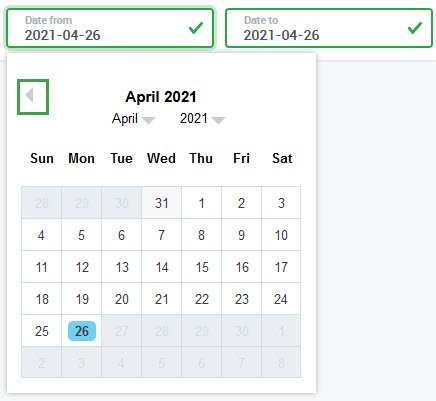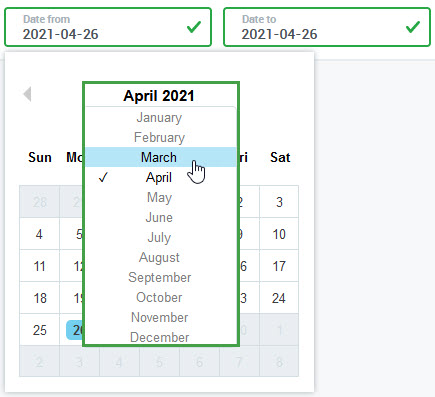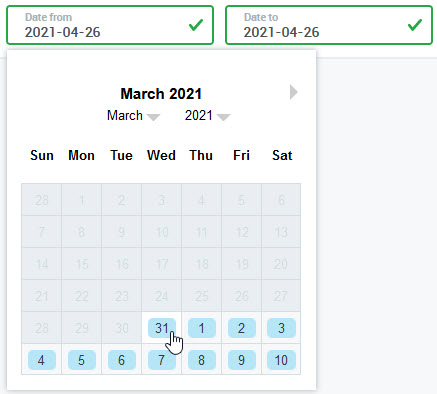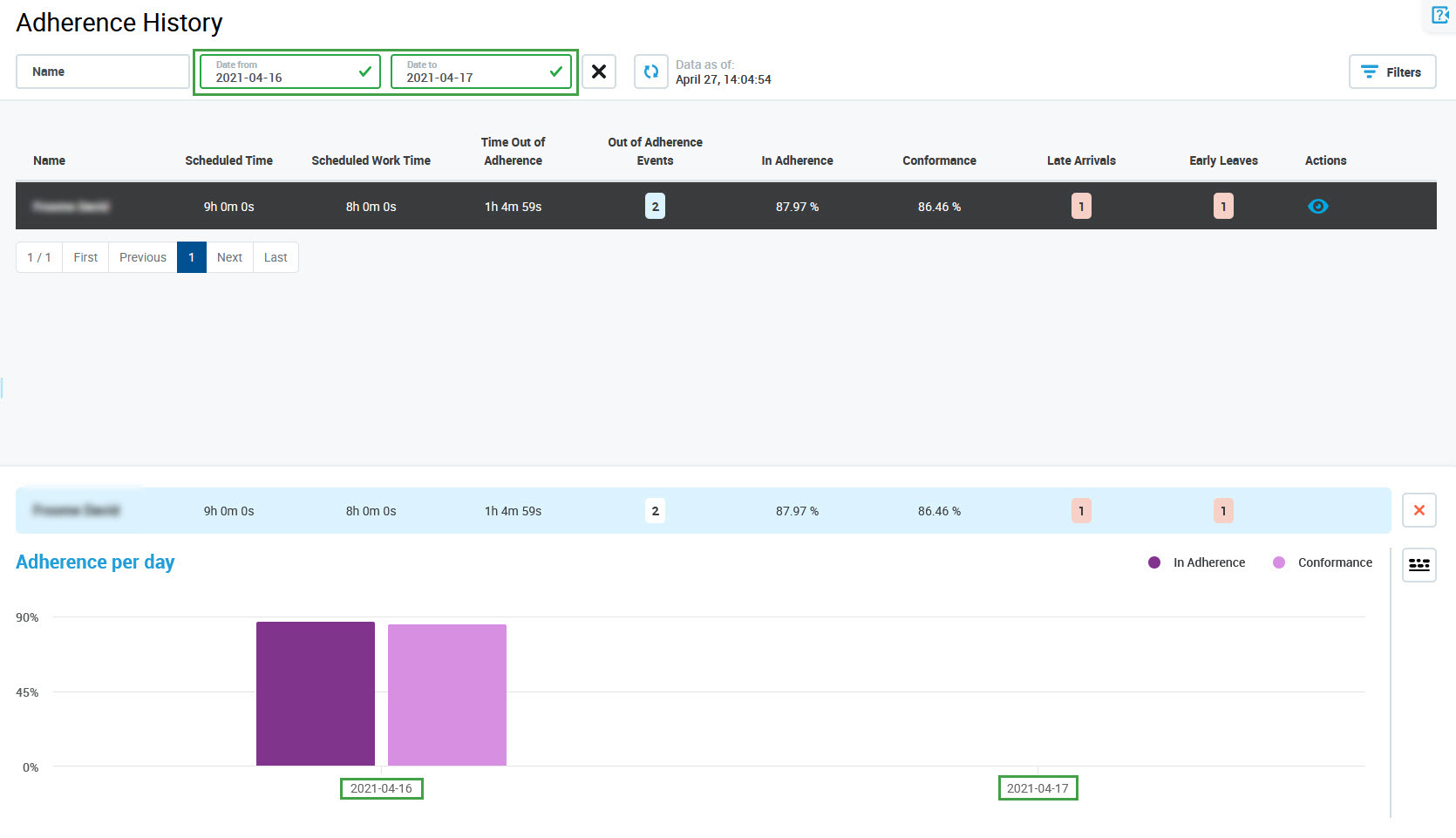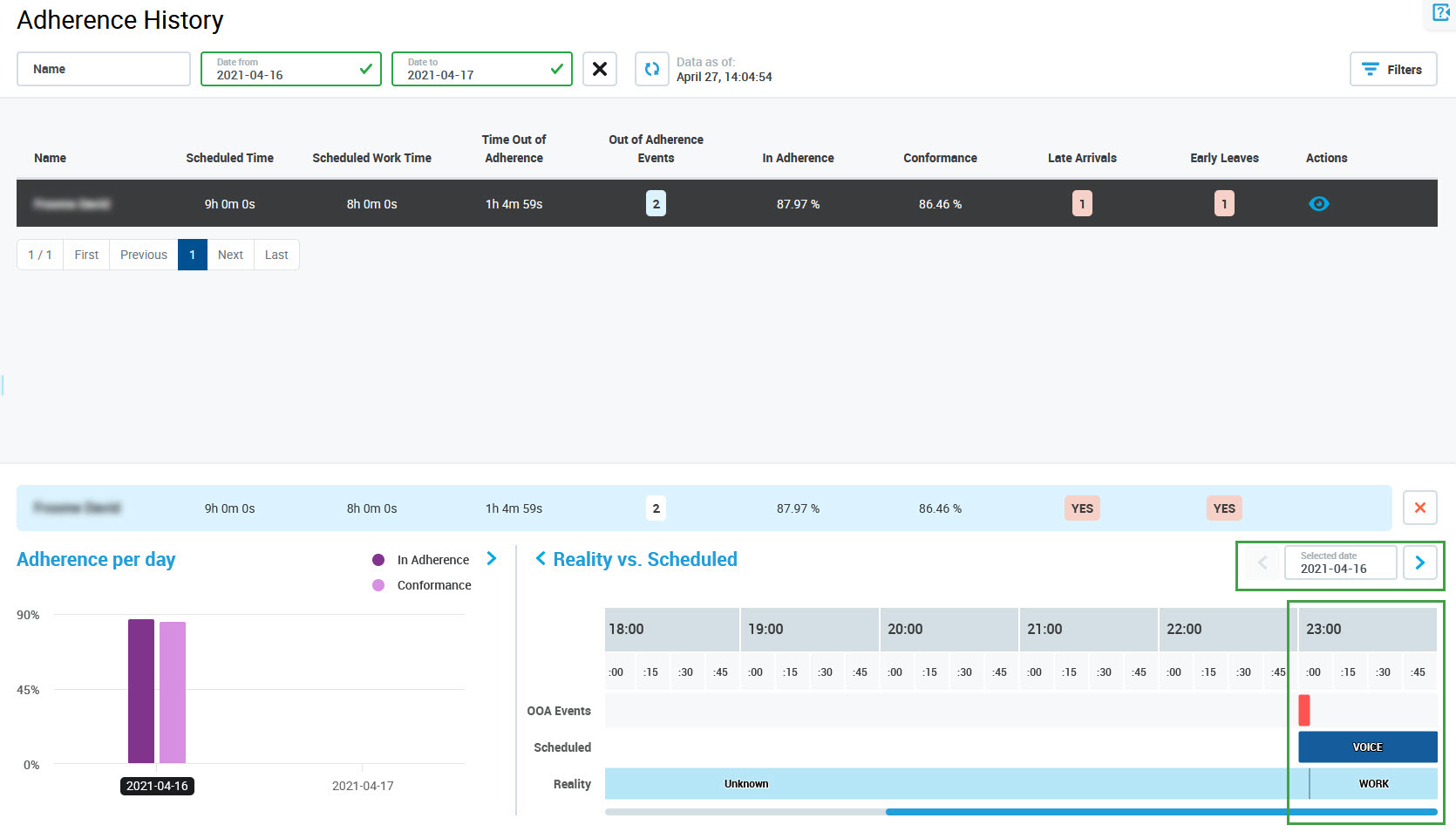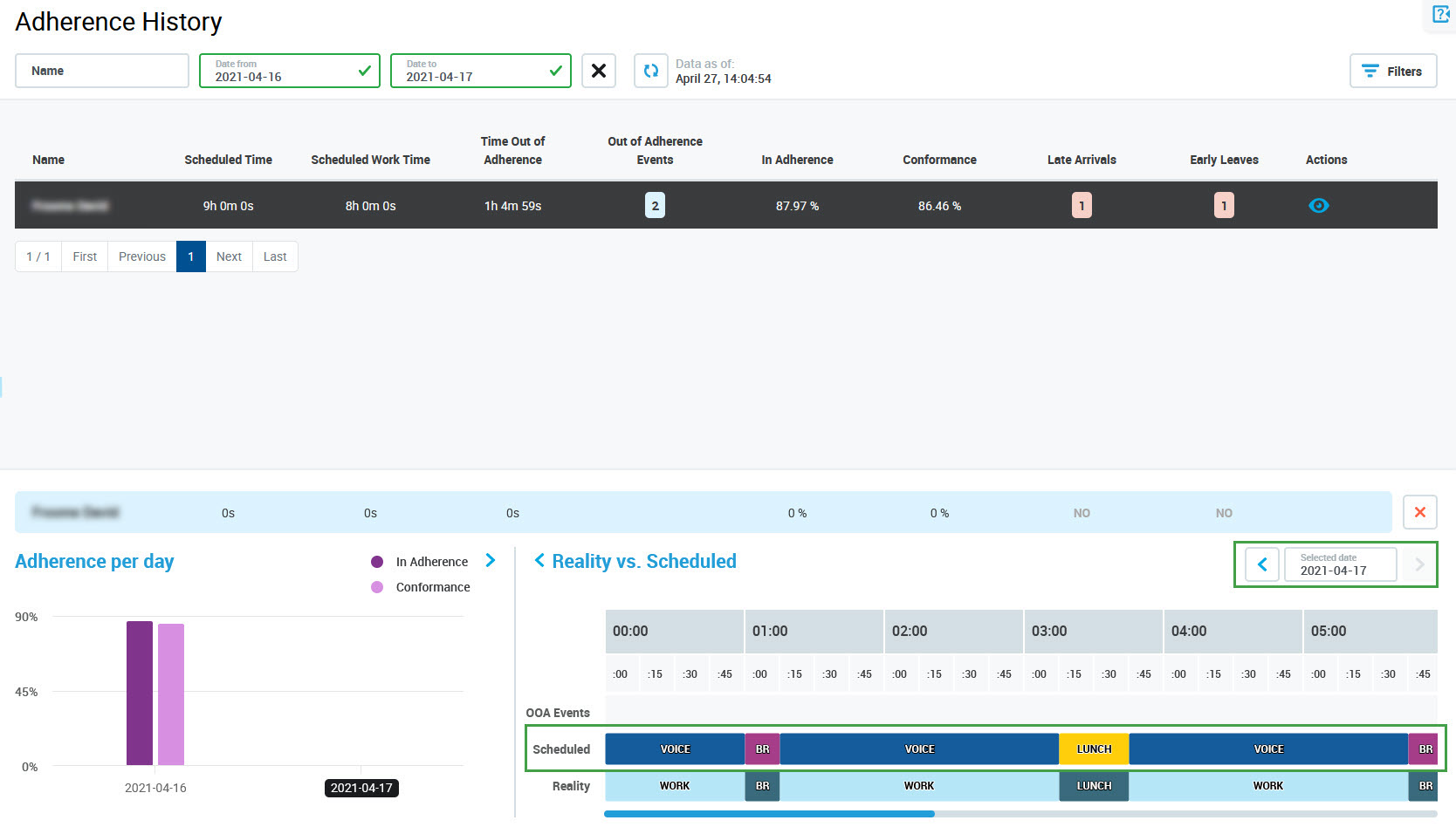Overview
The Schedule Adherence report allows supervisors to display detailed information about people's adherence to a schedule. Based on this, they are able to identify whether people follow their schedules and if they come to work or leave as planned. It is possible to select the date range displayed (the maximum range is the range of imported data). If multiple days are selected, data in the report for each person are summed up. The Filters functionality allows the report to be filtered based on the event’s details.
Please note that if a schedule that is older than 30 days is taken out of production and then put in production again, schedule adherence data older than 30 days will be lost. The reason for that is that schedule adherence data are recalculated with every update of the schedule based on raw people's statuses that are kept for 30 days only.
Displaying Adherence History
To display the Adherence History report, expand the Schedule Adherence module within the navigation tree and click Adherence History. The Adherence History screen will display.
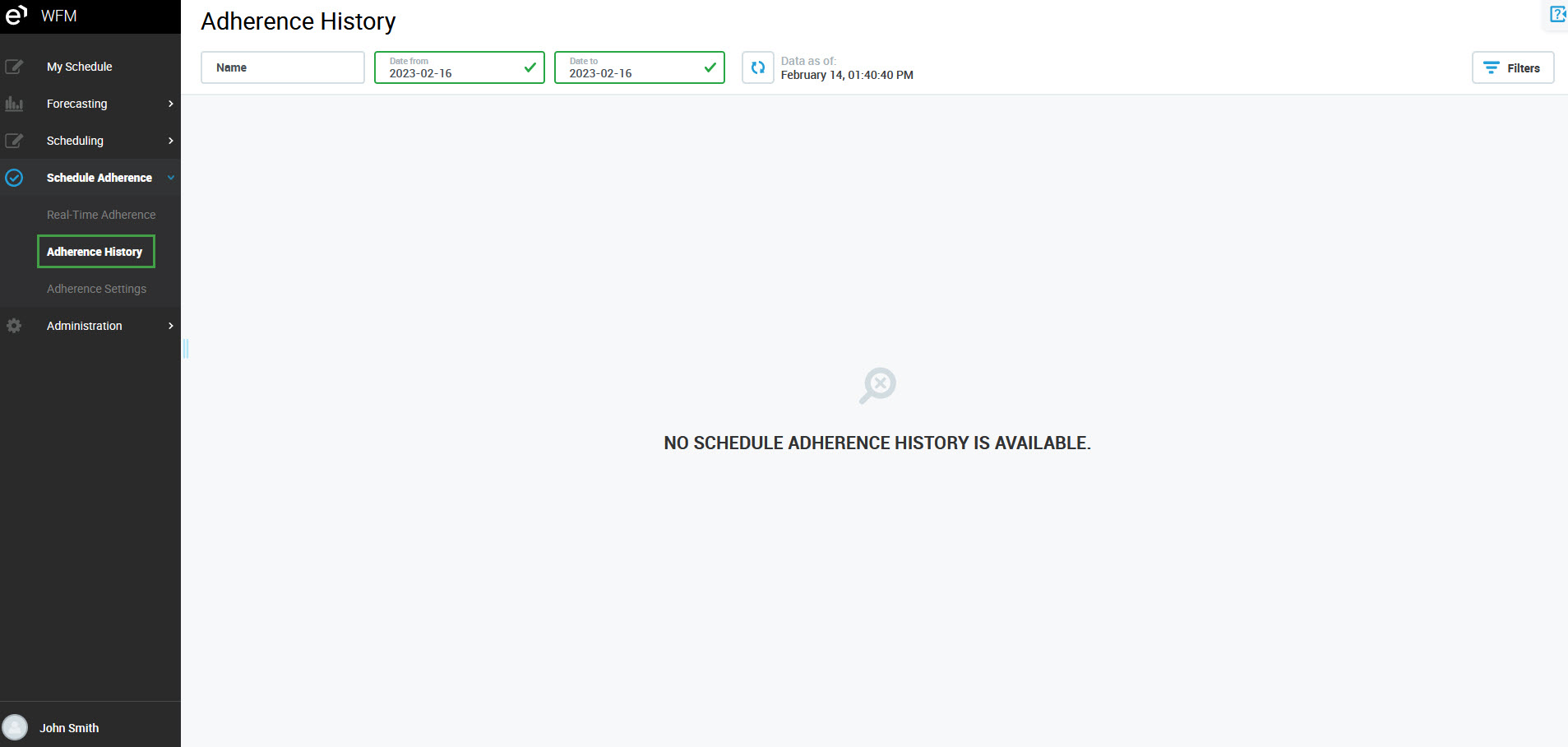
By default, the current day is selected. Click on the Date from and Date to fields to select a different date range.
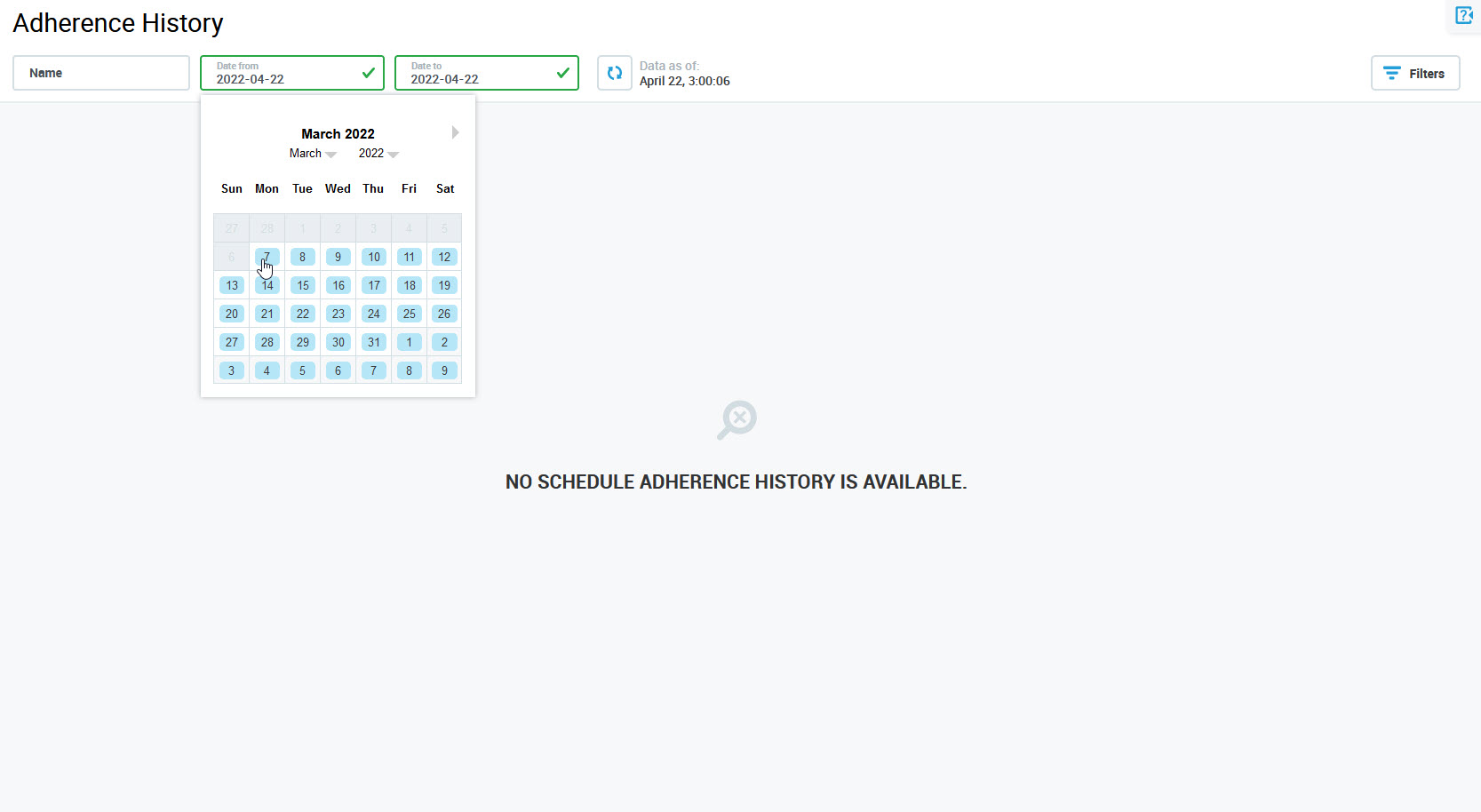
How to configure a date range?
The Adherence History report will display:

Agents who belong to the teams that the current user has assigned in User Management → Can Review section are available. Details can be found in the Can Review section of the Editing Users page.
Please note that adherence history is reported based on the time of a person's shift (the time zone which is set for this person in User Management). Select the correct time zone for each person in User Management to ensure that the Schedule Adherence history is correctly calculated and displayed on the timeline.
The date of the last data import is indicated at the top of the screen. Click on the Refresh button to ensure that the data is up to date.

The report data are divided into the following columns:
-
Name – name of the person
-
Teams – all teams that the person belongs to
-
Scheduled Time – total scheduled time (includes all scheduled activities, except Vacation, Sick and Holiday)
-
Scheduled Work Time – total scheduled work time (Voice, Chat, Email, Meeting, One on One, Training activities)
-
Time Out of Adherence – total time when a person was out of adherence
-
Out of Adherence Events – number of events when a person was out of adherence
-
In Adherence – percentage of time when a person really worked and was scheduled to work (includes call time, after call wrap, and scheduled activities like meetings or trainings), maximum is 100%
-
Conformance – percentage of time when a person was scheduled to work and they actually worked, can exceed 100%
-
Late Arrivals – number of late arrivals to work
-
Early Leaves – number of times the agent departed earlier than expected
The Action column allows further action related to the person:
-
the View button allows the details to be viewed, but not modified – this option is available to a user with the WFM_ANALYST role assigned and to a user with the WFM_SCHEDULER role assigned.
Viewing Details
Click the View button to display the adherence report for the selected person.
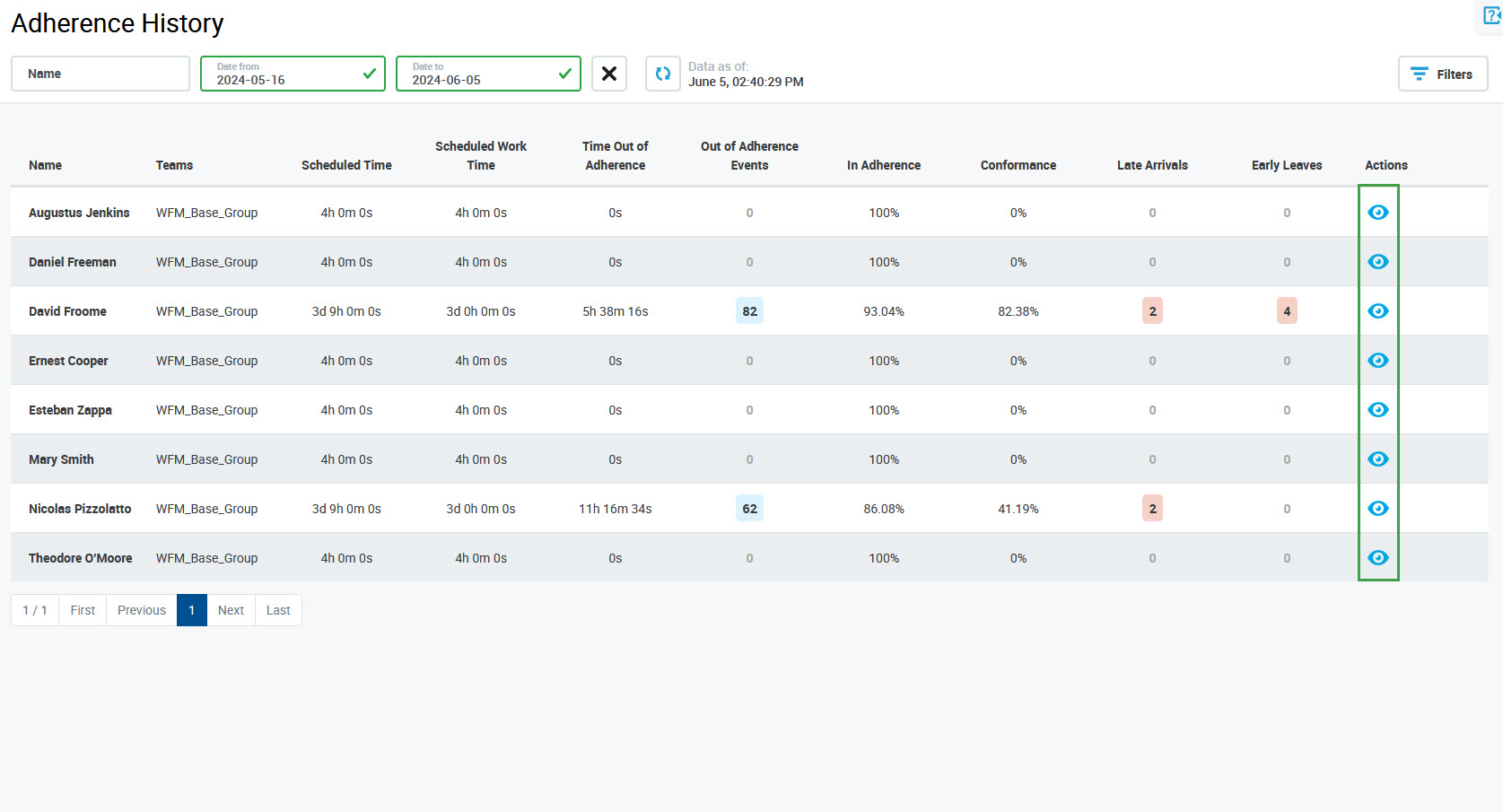
The details will display at the bottom of the screen.
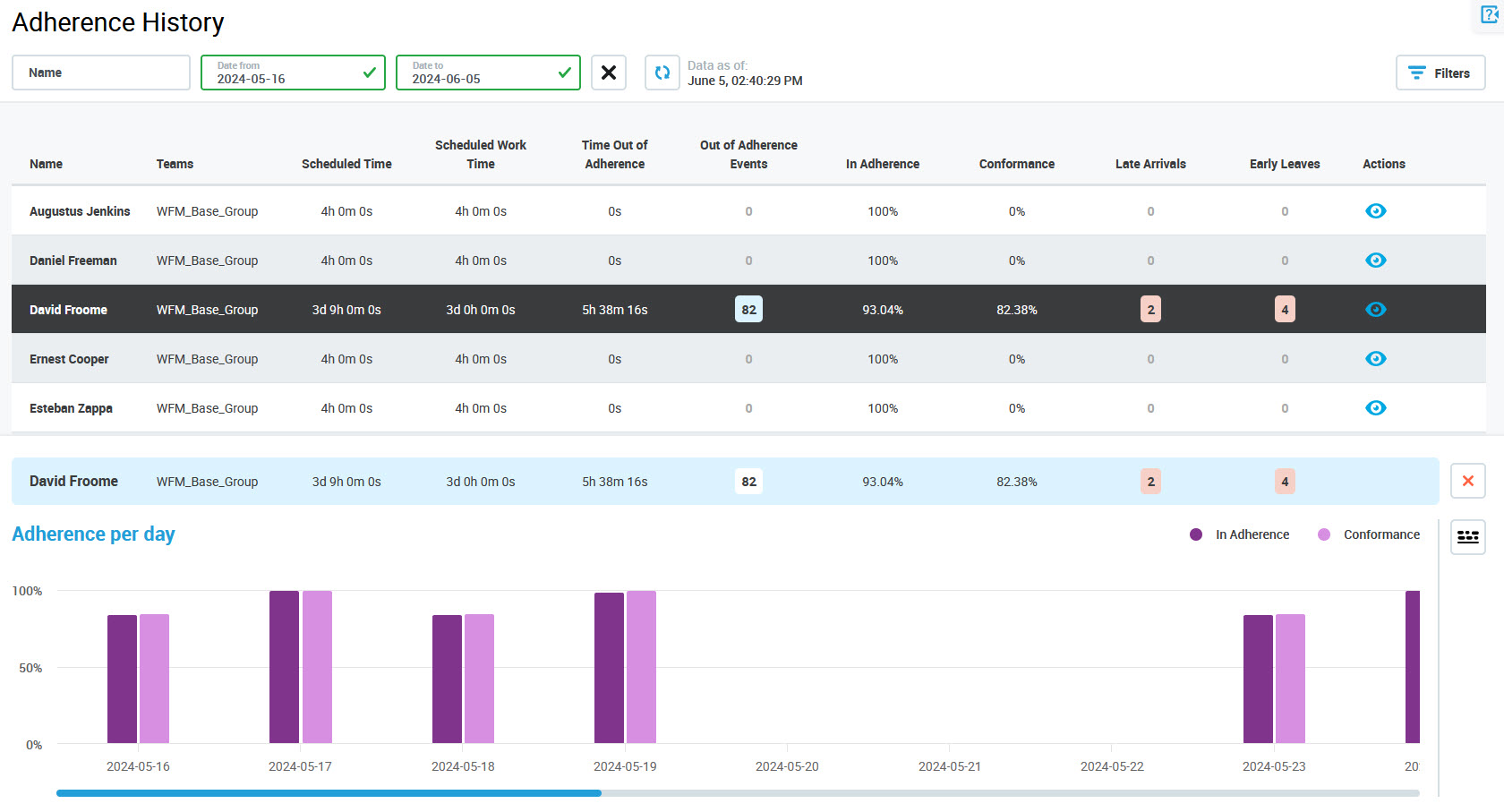
The adherence report for the selected person is displayed just above the graph.

-
The maximum date range is limited to the date range of imported data. However, the detailed view (the Reality vs. Scheduled timeline) is only available for the last 30 days. If the 'Date to' value is more than 30 days in the past, the View button is not active (details cannot be viewed).
-
If the selected date range contains one day only, the graph will not display. The Reality vs. Scheduled timeline will display instead.
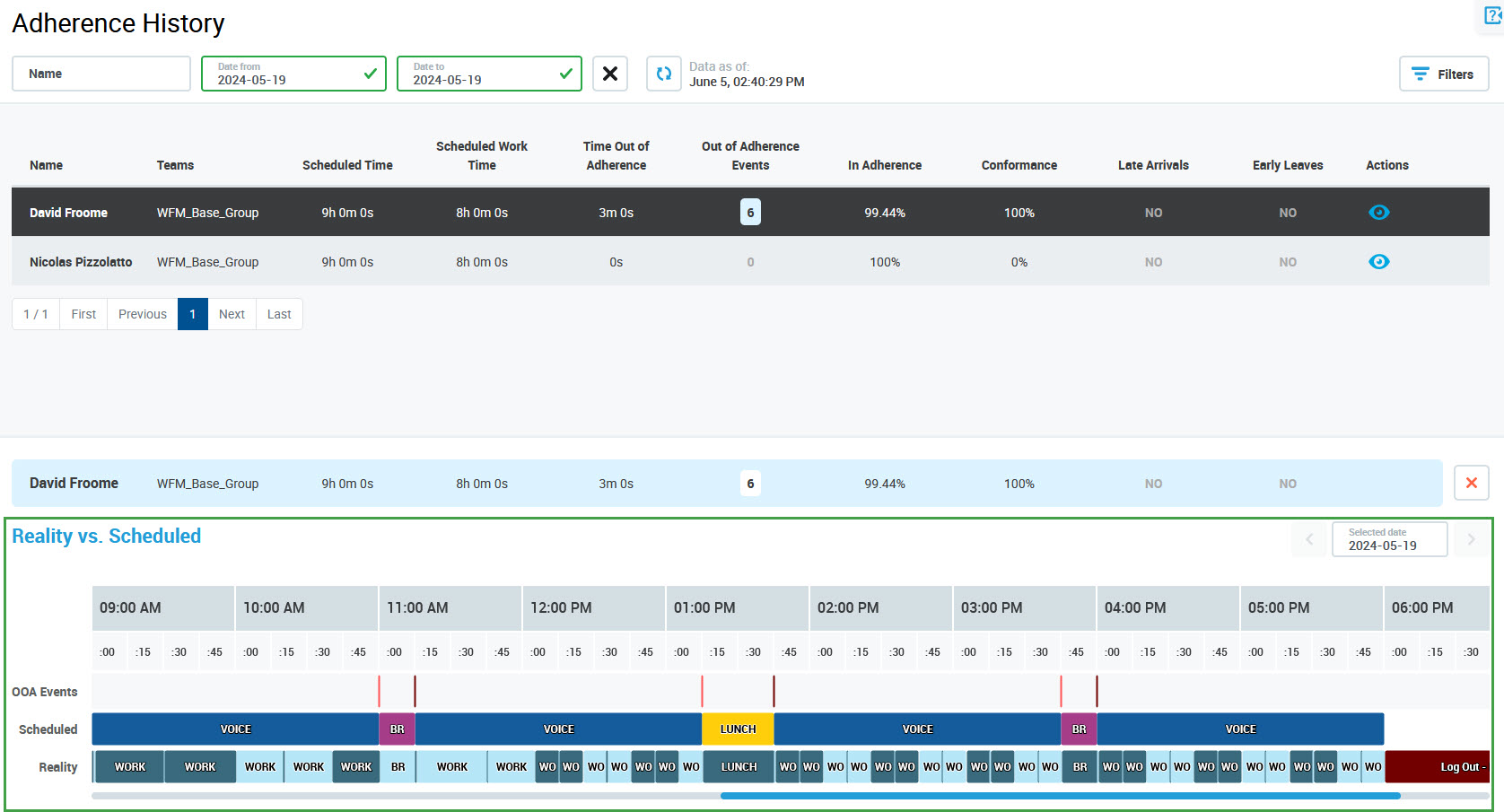
Adherence per Day
The graph that displays by default illustrates adherence per day for the selected person. The left bar (dark pink) shows the time in adherence, while the right bar (light pink) shows conformance (both in percent).

Hover the mouse pointer over the bars to display a tooltip with details:

The tooltip contains the same information as the table above but calculated for the particular day only:
-
Scheduled Time – total number of scheduled hours (includes all scheduled activities, except Vacation, Sick and Holiday)
-
Scheduled Work Time – total number of scheduled work hours (Voice, Chat, Email, Meeting, One on One, Training activities)
-
Time Out of Adherence – total number of hours when the person was out of adherence
-
Out of Adherence Events – number of events when the person was out of adherence
-
In Adherence – percentage of time when the person really worked and was scheduled to work (includes call time, after call wrap, and scheduled activities like meetings or trainings);
-
Conformance – percentage of time when the person was scheduled to work and they actually worked
-
Late Arrivals – number of late arrivals to work
-
Early Leaves – number of early departures from work
Note the following values:
Late Arrival – This out-of-adherence event is logged when before the beginning of the schedule, a person doesn't set a status that is mapped with the first scheduled activity.
Early Leave – This out-of-adherence event is logged when before the end of the schedule, a person sets a status that is not mapped to the currently scheduled activity and remains in this status until the end of the schedule for this day.
Reality vs. Scheduled
Click the Daily overview button on the right to compare real events with the schedule for a particular day. Alternatively, click on the bar on the Adherence per day graph to display the timeline for the selected day.

The Adherence per day graph will shrink and the Reality vs. Scheduled timeline will display in the bottom right corner of the screen.

By default, the first day of the selected date range will display. If the timeline was displayed by clicking on a bar, the selected day will display.
Use the arrows to navigate between days or click on a different day on the Adherence per day graph.

Use an arrow (the Full Width button) to expand the timeline to the full width of the screen and hide the Adherence per day graph.

The timeline for a day contains the following rows:
-
OOA Events – time when a person is out of adherence (marked in red)
-
Scheduled – scheduled activities
-
Reality – Eleveo Statuses based on the real statuses of the person

Evaluating Out of Adherence
The OOA Events row highlights in red all periods when a person was out of adherence. It is evaluated based on the mapping of scheduled activities to ACD Statuses set by a person. If the real status (ACD Status) set by the person is not mapped to the activity scheduled for the same time (mappings are configured on the Adherence Settings page), it is evaluated as out of adherence and marked in red in the OOA Events row.
If the ACD Status is added to an Eleveo Status (on the Adherence Settings page), the name of the Eleveo Status will display in the Reality row. However, if the ACD Status that appeared in the adherence history was not added to any Eleveo Status, the real name of the ACD Status will display in the Reality row.
Hover the mouse pointer over the OOA Events to display a tooltip with details.

The tooltip contains the following information about an event:
-
Schedule Activity – person's activity according to the schedule
-
Person's Status – real status set by the person (name of the Eleveo Status, or name of the ACD Status if the ACD Status is not added to any Eleveo Status)
-
OOA Start – beginning of the out of adherence event
-
OOA Duration – duration of the out of adherence event
Hover the mouse pointer over a Scheduled event to display the tooltip with details.

The tooltip contains the following information about an event:
-
Schedule Activity – name of the event (scheduled activity)
-
Duration – duration of the event
Hover the mouse pointer over a Reality event to display the tooltip with details.

The tooltip contains the following information about an event:
-
Person's status – name of the event (name of the Eleveo Status, or name of the ACD Status if the ACD Status is not added to any Eleveo Status)
-
Duration – duration of the event
Example
A person was scheduled to have a lunch break from 13:15 to 13:45 (yellow activity on the timeline), and to work before and after this break (dark blue activities on the timeline)
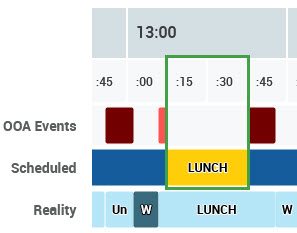
However, the real data does not match the schedule. The person logged 'lunch' status in the ACD person around 13:10, and it lasted until 13:55.
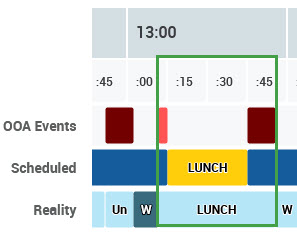
As a result, out of adherence events are marked from 13:10 to 13:15, and from 13:45 to 13:55.

Zooming the Timeline
By default, the timeline represents one day, but periods without any events at the beginning and at the end of the day are cut out. Use the scroll bar at the bottom to scroll the timeline:

To zoom in on the timeline, click on the area of the OOA Events/Scheduled/Reality bars (not on the hours or minutes) and keeping the mouse button pressed, move along the period that should be zoomed, for example from 12:00 to 15:00.

The selected period of time will be zoomed in.

It can be maximally zoomed in to display a 15 minute block of time.

Now, the scroll bar is not available at the bottom, but the timeline can be moved using the zoom function on the far right/left of it.

As a result, the timeline will move:

Click Reset zoom to display the full timeline.

Switching Back to Adherence per Day
Click the Multi-Day Overview button to display the Adherence per day graph.

Use an arrow (the Full Width button) to expand the graph to the full width of the screen and hide the timeline.

Click the Close button to hide details. Alternatively, click the View button to display details for a different person.
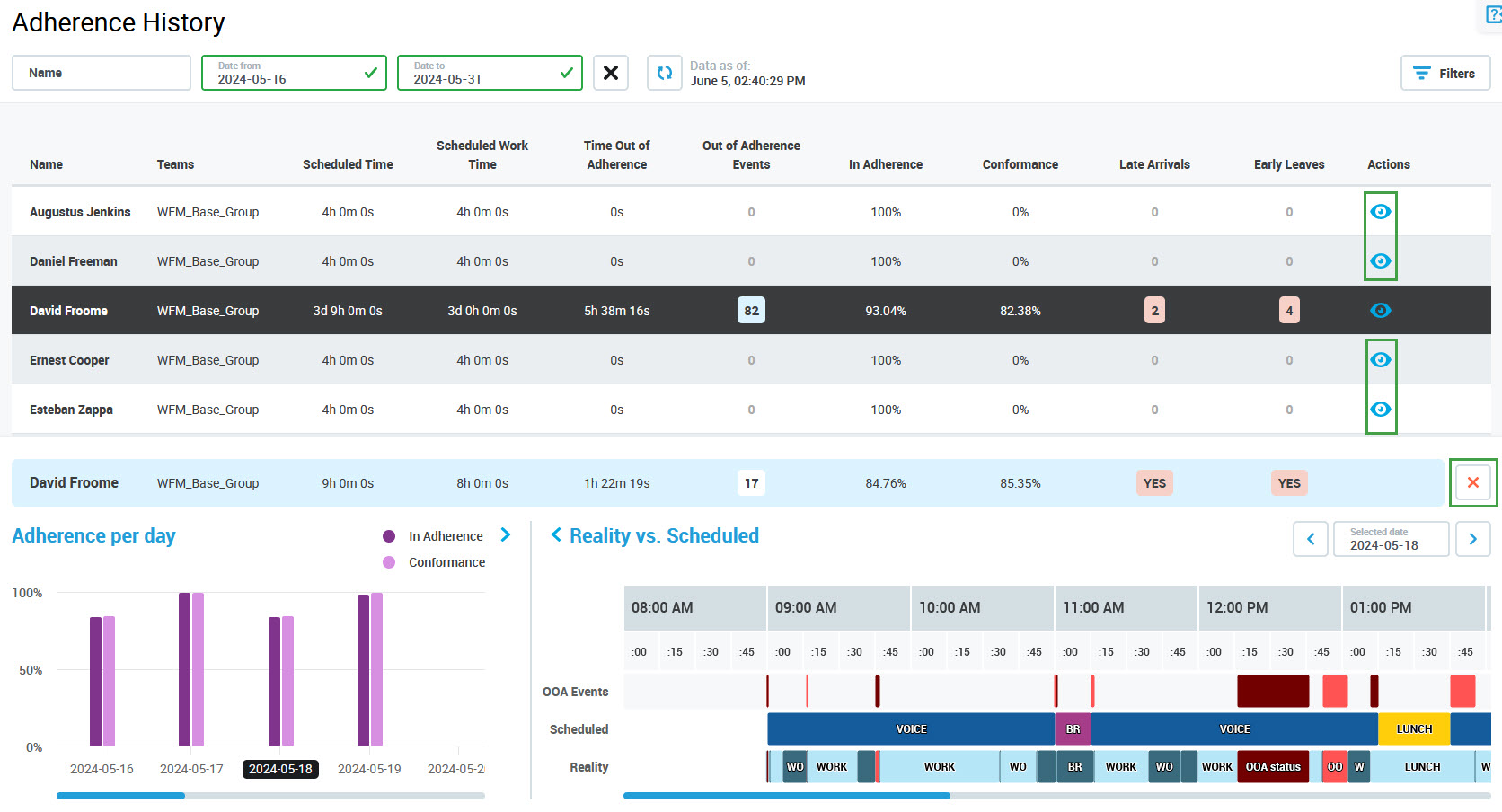
Filtering Adherence History Reports
It is possible to filter the Adherence History reports that will be displayed, based on a name or based on configured criteria.
Filtering Based on a Person's Name
Enter the name of a person in the Name field to find the reports for this person. Search is not case-sensitive. Results will be dynamically displayed while entering the name. Click the Reset filter button to remove the name.
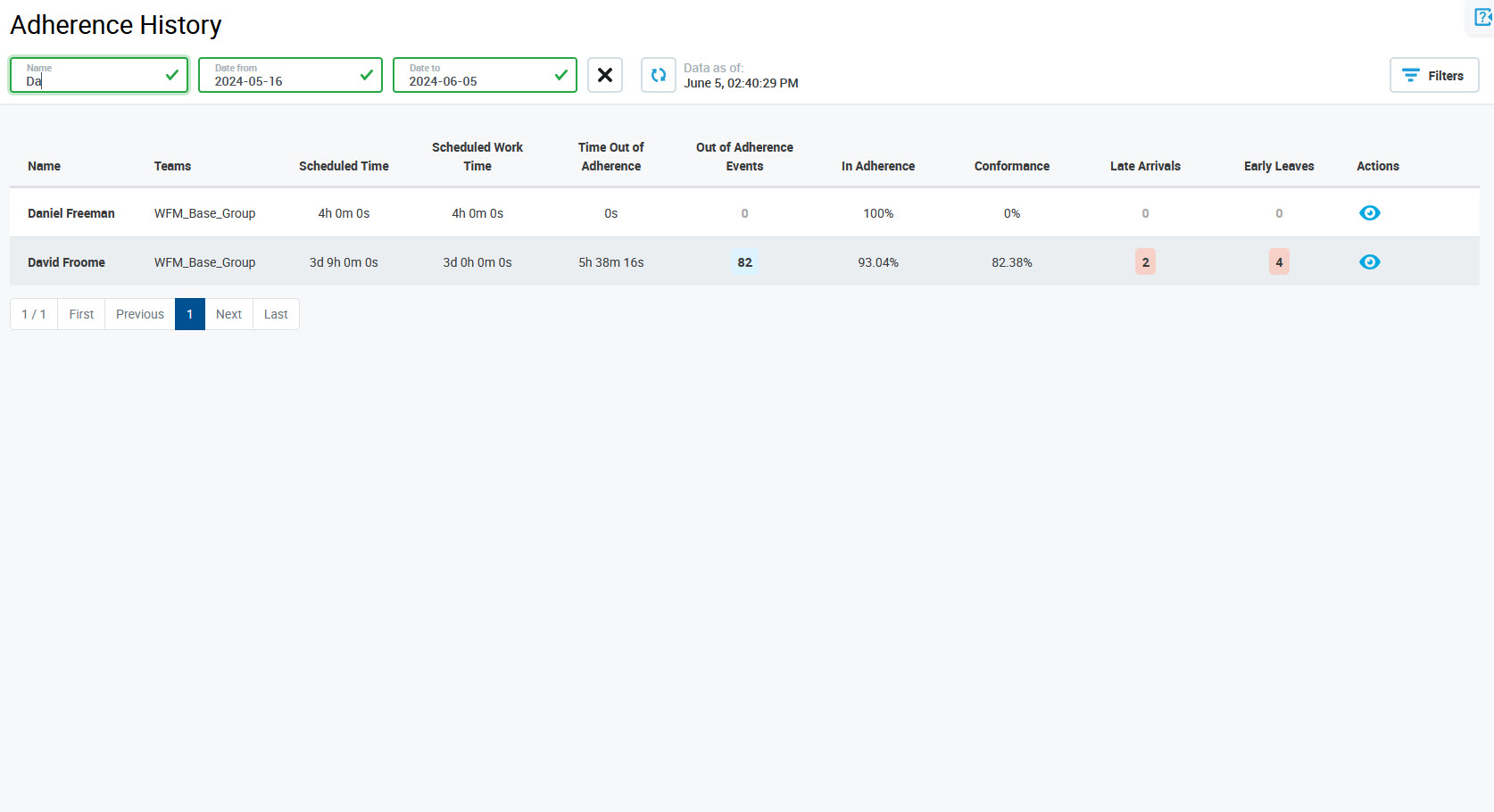
Filtering Based on Criteria (Filters)
To filter reports based on configurable criteria, click on the Filters button in the top right corner of the screen. The filters pane will display.
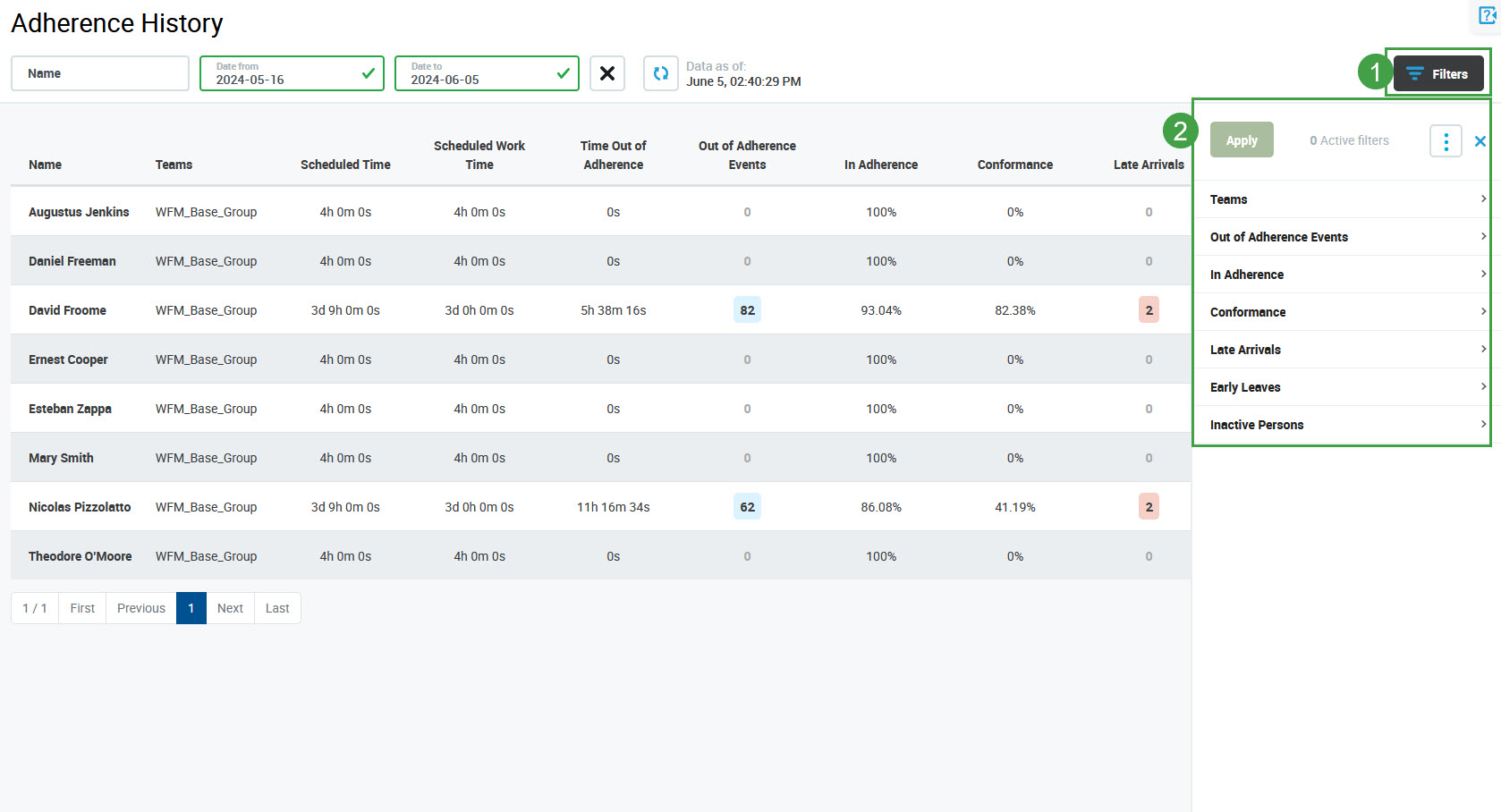
Click the individual tabs to expand them and to display the following filtering criteria:
-
Teams – displays only people who belong to the selected team (only the teams that are managed by the person who is filtering are displayed)
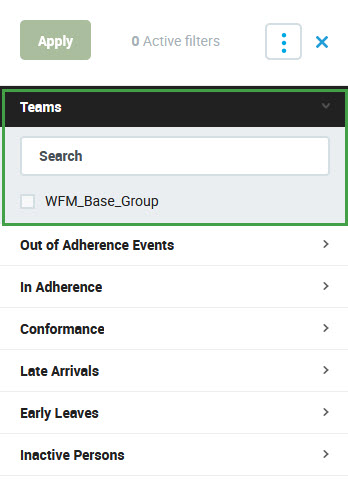
-
Out of Adherence Events – displays only people with the defined number of events, provide a min and/or max value
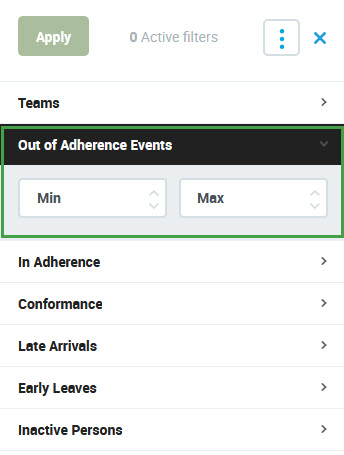
-
In Adherence – displays only people with the defined value, provide a min and/or max value (in percent)
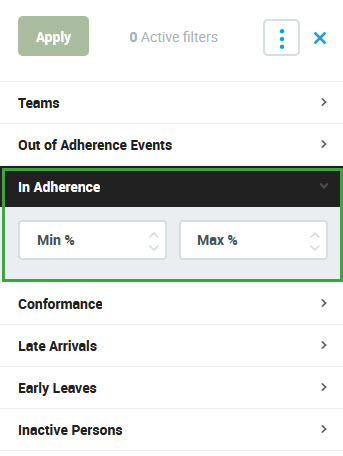
-
Conformance – displays only people with the defined value, provide a min and/or max value (in percent)
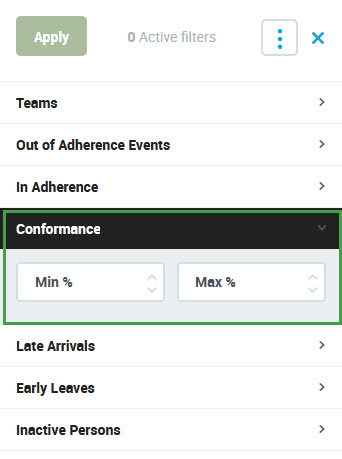
-
Late Arrivals – displays only people with or without late arrivals, select one option
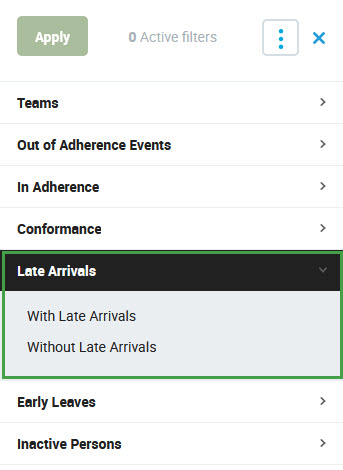
-
Early Leaves – displays only people with/without late arrivals, select one option
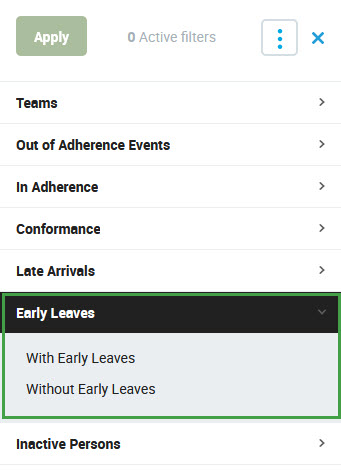
-
Inactive Persons – select if the reports of inactive people should be displayed
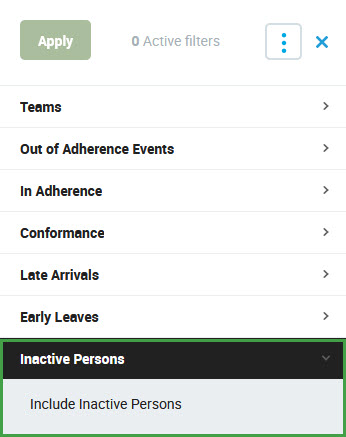
To read more about how to use filters, visit the page Using Filters.


